Please see the updated captive-bred marine fish species list for 2023!
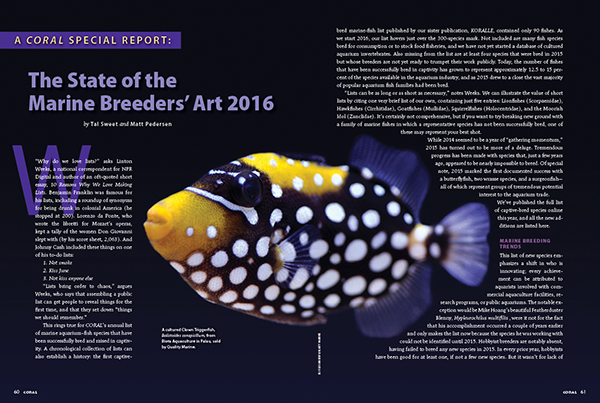
CORAL Magazine’s Annual Report on the state of marine aquarium breeder efforts, with cultured Clown Trigger being sold by Quality Marine and raised by Biota Marine, Palau. Image: Eli Fleishauer.
A CORAL SPECIAL REPORT: The State of the Marine Breeders’ Art 2016
by Tal Sweet and Matt Pedersen
CORAL Magazine’s Annual Listing of captive-bred marine aquarium fish species, current through early December 2015 – an excerpt from the January/February 2016 issue of CORAL Magazine – subscribe today!
“Why do we love lists?” asks Linton Weeks, a national correspondent for NPR Digital and author of an oft-quoted short essay, 10 Reasons Why We Love Making Lists. Benjamin Franklin was famous for his lists, including a roundup of synonyms for being drunk in colonial America (he stopped at 200). Lorenzo da Ponte, who wrote the libretti for Mozart’s operas, kept a tally of the women Don Giovanni slept with (by his score sheet, 2,063). And Johnny Cash included these things on one of his to-do lists:
- Not smoke
- Kiss June
- Not kiss anyone else
“Lists bring order to chaos,” argues Weeks, who says that assembling a public list can get people to reveal things for the first time, and that they set down “things we should remember.”
This rings true for CORAL’s annual list of marine aquarium–fish species that have been successfully bred and raised in captivity. A chronological collection of lists can also establish a history: the first captive-bred marine-fish list published by our sister publication, KORALLE, contained only 90 fishes. As we start 2016, our list hovers just over the 300-species mark. Not included are many fish species bred for consumption or to stock food fisheries, and we have not yet started a database of cultured aquarium invertebrates. Also missing from the list are at least four species that were bred in 2015 but whose breeders are not yet ready to trumpet their work publicly. Today, the number of fishes that have been successfully bred in captivity has grown to represent approximately 12.5 to 15 percent of the species available in the aquarium industry, and as 2015 drew to a close the vast majority of popular aquarium fish families had been bred.
“Lists can be as long or as short as necessary,” notes Weeks. We can illustrate the value of short lists by citing one very brief list of our own, containing just five entries: Lionfishes (Scorpaenidae), Hawkfishes (Cirrhitidae), Goatfishes (Mullidae), Squirrelfishes (Holocentridae), and the Moorish Idol (Zanclidae). It’s certainly not comprehensive, but if you want to try breaking new ground with a family of marine fishes in which a representative species has not been successfully bred, one of these may represent your best shot.
While 2014 seemed to be a year of “gathering momentum,” 2015 has turned out to be more of a deluge. Tremendous progress has been made with species that, just a few years ago, appeared to be nearly impossible to breed. Of special note, 2015 marked the first documented success with a butterflyfish, two wrasse species, and a surgeonfish (tang) — all of which represent groups of tremendous potential interest to the aquarium trade. We’ve published the full list of captive-bred species online this year, and all the new additions are listed here.
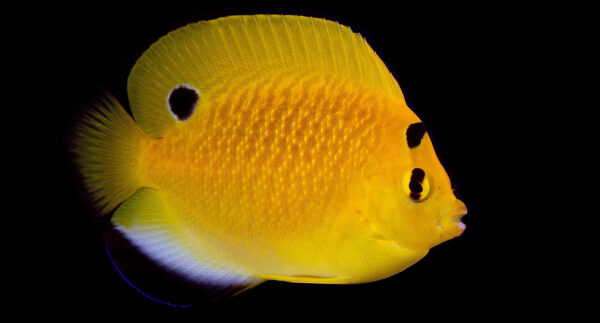
An accidental young hybrid of Flagfin and Goldflake Angels (Apolemichthys trimaculatus x A. xanthopunctatus) from Bali Aquarich. Image: Lemon Tea Yi Kai
MARINE BREEDING TRENDS
This list of new species emphasizes a shift in who is innovating; every achievement can be attributed to aquarists involved with commercial aquaculture facilities, research programs, or public aquariums. The notable exception would be Mike Hoang’s beautiful Featherduster Blenny, Hypleurochilus multifilis, were it not for the fact that his accomplishment occurred a couple of years earlier and only makes the list now because the species he was working with could not be identified until 2015. Hobbyist breeders are notably absent, having failed to breed any new species in 2015. In every prior year, hobbyists have been good for at least one, if not a few new species. But it wasn’t for lack of trying: When the Marine Breeding Initiative hosted its sixth annual MBI Workshop in 2015, it was attended by over 70 individuals from around North America. The MBI continues to lead the way in sharing captive breeding information with aquarists all over the world.
Some breeders elected to reexamine and refine species that, while not “new” to the captivebred list, had long been forgotten. Proaquatix wowed aquarists by making captive-bred Jackknife Fish, Equetus lanceolatus, commercially available. This species was first cultured decades ago, but hadn’t been revisited and has never been available to the public as a captive-bred offering. In addition to reviving past species, Tami Weiss of FusedJaw.com helped uncover and verify several species of seahorse and pipefish that have been successfully cultivated around the world in years past, but have never been included on our lists until now (you can see these species listed on the online master list).
Tom Bowling and Biota Marine of Palau led the charge of commercial producers, claiming success with nine new species never before seen as captive-bred fishes. Among the many new genera they reared, arguably the most attention-grabbing was the Clown Triggerfish (Balistoides conspicillum). Breeding this prized species in captivity is a dream that has haunted commercial breeders for decades. More importantly, although it was not the first captive-bred triggerfish ever, the Clown Trigger was the first to be supplied on a commercial scale (by Quality Marine) in the United States.
Bali Aquarich upped their angelfish game by adding three more new species to their list this year; they are currently the world’s leading supplier of captive-bred marine angelfishes. Bali also delighted the aquarium audience with the production of two unique large angelfish hybrids. The first, a hybrid between the Flagfin and Goldflake Angelfishes (Apolemichthys trimaculatus X A. xanthopunctatus) has been dubbed the “Faux Gold”; so far we’ve only been shown juveniles, which are mainly yellow in coloration. Outwardly more unique, the accidental hybrid of the Emperor and Annularis Angelfishes (Pomacanthus imperator X P. annularis) turned heads and, upon maturity, displayed a unique blending of traits from both parental species.
Commercial breeders based in the US have had a few successes of their own: Oceans, Reefs and Aquariums (ORA) is now producing the unusually small-for-its-genus and reef-safe Radial Filefish, Areichthys radiatus (see Rarities excerpt), as well as the Transparent Cave Goby, Fusigobius pallidus, and they surprised us with three other new accomplishments they’d not shared previously (see list, below).
Frank Baensch, known for his work at Reef Culture Technologies as one of the world’s pioneering angelfish breeders, finally broke the butterflyfish barrier with captive- bred Chaetodon kleinii. Although Baensch and Rising Tide had a few “near misses” in the preceding years, it was truly only a matter of persistence and time until the work paid off. Wrasses featured prominently this year; in the past Bali Aquarich accidentally reared several of the Cleaner Wrasse, Labroides dimidiatus, the first aquarium-size captive-bred wrasse, but that was it for a while. Two more wrasses were cultured this year: Baensch bred Halichoeres ornatissimus and Kevin Barden became the first to breed the Melanurus Wrasse, Halichoeres melanurus. Barden’s work with the Rising Tide Conservation program at the Tropical Aquaculture Laboratory in Florida highlights the growing success of institutional and academic research in the field of marine ornamental aquaculture.
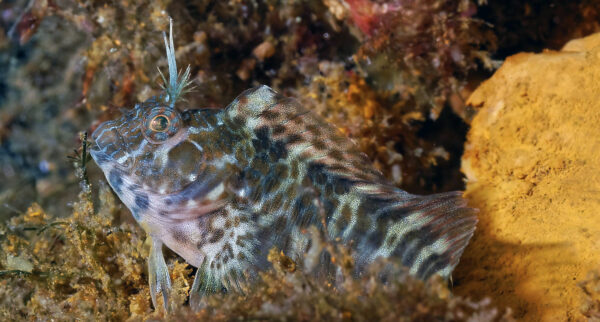
Featherduster Blenny from the Gulf of Mexico, successfully bred by hobbyist Michael Hoang. Image: JIm Garin.
IN THE PUBLIC EYE
As for public aquariums, Noel Heinsohn of the Long Island Aquarium became the first person to successfully raise the beautiful Lyretail Anthias, Pseudanthias squamipinnis. This was the first reported success within the Anthiinae subfamily. One of the accomplishments that slipped under the public radar is the breeding of the Longspined Porcupinefish, Diodon holocanthus, at the Pittsburgh Zoo & PPG Aquarium. Jennifer Dancico and Josie Romasco share joint responsibility for this accomplishment, which was supported by a grant from the Institute of Museum and Library Services (IMLS) that funded larval fish workshops hosted by the New England Aquarium and Roger Williams University. Additionally, Monika Schmuck reports successes at the New England Aquarium rearing both the Planehead Filefish, Stephanolepis hispidus, and the Dusky Pipefish, Syngnathus floridae, using techniques from these workshops. Several other successes have occurred as a result of these workshops, and we hope to highlight them as soon as we are given permission to do so. Progress was made in New Zealand, as well: Kelley Tarlton of the Sea Life Aquarium in Auckland announced the first success with the rare Spiny Seadragon, Solegnathus spinosissimus. Not only is Sea Life the first institution to put adults on display, but the Aquarium is also raising offspring.
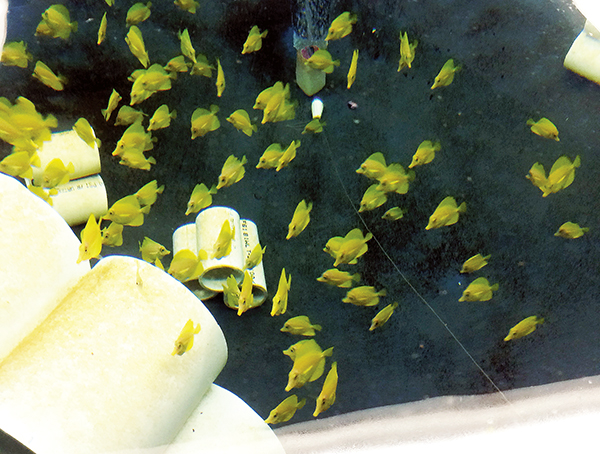
World’s first captive-bred surgeonfishes: Juvenile Yellow Tangs by the hundreds at Hawaii’s Oceanic Institute. Image: Chad Callan/OI Rising Tide.
The crown jewel on this year’s list has to be the Yellow Tang, Zebrasoma flavescens (see CORAL Magazine, January February 2016, page 36, ). After decades of trial and error, this much-sought-after species has been successfully bred in captivity at the Oceanic Institute in Waimanalo, Hawaii, in a joint project with Rising Tide Conservation. A supply of aquacultured Yellow Tangs, one of the most popular fishes in the hobby, has been on many aquarists’ wish lists for some time. This breakthrough bodes well for the future propagation of other members of the genus and of the surgeonfish family, including the Pacific Blue Tang, Paracanthurus hepatus, which is reported to be overharvested in a number of collection areas. (See Ret Talbot’s report and essay, CORAL Magazine, Jan/Feb 2016, page 104.)
All in all, it is astonishing to see the major strides that were taken and the boundaries that were crossed during the past year, but it is vital to know there is a bigger picture. While captive breeding is a high priority for the hobby and the trade, it must be coupled with regulated, sustainable wild fisheries in order for both to remain viable and diverse.
ON THE INTERNET
Marine Breeders Initiative database of species bred in captivity:
http://www.mbisite.org
Weeks, Linton. 2009. 10 Reasons Why We Love Making Lists.
http://www.npr.org/templates/story/story.php?storyId=101056819
IMLS Grant to New England Aquarium & Roger Williams University:
https://www.imls.gov/grants/awarded/mp-00-12-0024-12
Get the full report in print, including more stunning images as a CORAL Magazine subscriber. Don’t miss out, subscribe today!
The new 2016 Captive Bred Marine Fish Species List now supersedes the 2015 list, the 2014 list and the 2013 list. Color-coded perceived availability in the United States during 2015 has been included this year:
Orange Common Name = new to the list this year.
Pink Common Name = new to the list this year, but as a priorly overlooked accomplishment
Green = Commonly Available. Easy to find as a captive-bred fish, often from more than one source, throughout 2015 and/or into 2016.
Blue – Moderate to Low. Might have taken some searching, and availability may have been limited, but was reasonably obtainable as a captive-bred fish in 2015.
Purple = Scarce. Generally only one source or breeder is known, and potentially only a handful of specimens may have been available. You may have “had to know someone” or even know the breeder directly in order to obtain them as captive-bred fish during 2015.
Black = None. The authors and consulted parties were unaware of any retail availability of this species from a captive-bred source during 2015.
Angelfishes (Pomacanthidae)
Apolemichthys arcuatus, Bandit Angelfish
Apolemichthys trimaculatus, Flagfin Angelfish
Centropyge acanthops, African pygmy Angelfish
Centropyge argi, Cherub Angelfish
Centropyge colini, Collins or Cocos Keeling Angelfish
Centropyge debelius, Debelius Angelfish
Centropyge fisheri, Fisher’s Angelfish
Centropyge flavissima, Lemonpeel Angelfish
Centropyge interruptus, Japanese Pygmy Angel
Centropyge joculator, Joculator Angelfish
Centropyge loricula, Flame Angelfish
Centropyge multicolor, Multicolor Angelfish
Centropyge resplendens, Resplendent Angelfish
Chaetodontoplus cephalareticulatus, Maze Angelfish
Chaetodonotplus duboulayi, Scribbled Angelfish
Chaetodontoplus septentrionalis, Bluestriped Angelfish
Genicanthus personatus, Masked Angelfish
Genicanthus watenabei, Blackedged Angelfish
Holacanthus clarionensis, Clarion Angelfish
Holacanthus passer, Passer or King Angelfish
Paracentropyge multifasciata, Multibar Angelfish
Paracentropyge venusta, Purplemask Angelfish
Pomacanthus annularis, Annularis Angelfish
Pomacanthus arcuatus, Gray Angelfish
Pomacanthus asfur, Asfur Angelfish
Pomacanthus maculosus, Yellowbar Angelfish
Pomacanthus navarchus, Majestic or Blue Girdled Angelfish
Pomacanthus paru, French Angelfish
Pomacanthus semicirculatus, Koran Angelfish
Anthias (Serranidae)
Pseudanthias squamipinnis, Lyretail Anthias
Assessors (Plesiopidae)
Assessor flavissimus, Yellow Assessor
Assessor macneilli, Blue Assessor
Assessor randalli, Randal’s Assessor
Basslets (Serranidae)
Liopropoma carmabi, Candy Basslet
Liopropoma rubre, Swissguard Basslet
Batfishes (Ephippidae)
Chaetodipterus faber, Atlantic Spadefish
Platax bativianus, Zebra Batfish
Platax pinnatus, Pinnatus Batfish
Platax orbicularis, Orbiculate Batfish
Blennies (Blenniidae)
Chasmodes bosquianus, Striped Blenny
Ecsenius gravieri, Red Sea Mimic Blenny
Ecsenius bicolor, Bicolor Blenny
Enchelyurus flavipes, Goldentail Comb-tooth Blenny
Hypleurochilus multifilis, Featherduster Blenny
Hypsoblennius hentz, Feather Blenny
Meiacanthus atrodorsalis, Forktail Blenny
Meiacanthus bundoon, Bundoon Blenny
Meiacanthus grammistes, Striped Fang Blenny
Meicanthus kamohari, Kamohara Blenny
Meiacanthus mossambicus, Mozambique Fang Blenny
Meiacanthus nigrolineatus, Blackline Fang Blenny
Meiacanthus oualanensis, Canary Fang Blenny
Meiacanthus smithi, Disco Blenny
Meiacanthus tongaensis, Fang Blenny (Tonga)
Parablennius marmoreus, Seaweed Blenny
Petroscirtes breviceps, Mimic Fang Blenny
Salaria pavo, Peacock Blenny
Scartella cristata, Molly Miller Blenny
Boxfishes (Ostraciidae)
Acanthostracion quadricornis, Scrawled Cowfish
Butterflyfishes (Chaetodontidae)
Chaetodon klienii, Klien’s, Orange or Sunburst Butterflyfish
Cardinalfishes (Apogonidae)
Apogon notatus, Spotnape Cardinalfish
Apogonichthyoides melas, Black Cardinalfish
Apogonichthyoides nigripinnis, Bullseye Cardinalfish
Cheilodipterus quinquelineatus, 5 Lined Cardinalfish
Fowleria flammea, Red Stop Light Cardinalfish
Nectamia bandanensis, Bigeye Cardinalfish
Ostorhinchus compressus, Ochre-striped Cardinalfish
Ostorhinchus cyanosoma, Yellowstriped Cardinalfish
Ostorhinchus margaritophorus, Copper Lined Cardinalfish
Ostorhinchus quadrifasciatus, Two-striped Cardinalfish
Pterapogon kauderni, Banggai Cardinalfish
Pterapogon mirifica, Sailfin Cardinalfish
Sphaeramia nematoptera, Pajama Cardinalfish
Sphaeramia orbicularis, Orbic Cardinalfish
Zoramia leptacantha, Threadfin Cardinalfish
Marine Catfishes (Plotosidae)
Plotosus lineatus, Striped Eel Catfish
Clingfishes (Gobiesocidae)
Gobiesox punctulatus, Stippled Clingfish
Gobiesox strumosus, Skilletfish
Clownfishes (Pomacentridae)
Amphiprion akallopisos, Skunk Clownfish
Amphiprion akindynos, Barrier Reef Clownfish
Amphiprion allardi, Allard’s Clownfish
Amphiprion barberi, Fiji Barberi Clownfish
Amphiprion bicinctus, Red Sea (Two-Barred) Clownfish
Amphiprion chrysogaster, Mauritian Clownfish
Amphiprion chrysopterus, Orangefin Anemonefish
Amphiprion clarkii, Clarkii Clownfish
Amphiprion ephippium, Red Saddleback Clownfish
Amphiprion frenatus, Tomato Clownfish
Amphiprion latezonatus, Wide Band Clownfish
Amphiprion latifasciatus, Madagascar Clownfish
Amphiprion leucokranos, Whitebonnet Clownfish
Amphiprion mccullochi, McCulloch’s Clownfish
Amphiprion melanopus, Cinnamon Clownfish
Amphiprion nigripes, Blackfinned Clownfish
Amphiprion ocellaris, Ocellaris Clownfish
Amphiprion percula, Percula Clownfish
Amphiprion perideraion, Pink Skunk Clownfish
Amphiprion polymnus, Saddleback Clownfish
Amphiprion rubrocinctus, Australian Clownfish
Amphiprion sandaracinos, Orange Skunk Clownfish
Amphiprion sebae, Sebae Clownfish
Amphiprion tricinctus, Three-Band Clownfish
Premnas biaculeatus, Maroon Clownfish
Convict Blennies (Pholidichthyidae)
Pholidichthys leucotaenia, Convict Blenny, Engineer Goby
Damselfishes (Pomacentridae)
Abudefduf saxatilis, Sergeant Major
Acanthochromis polyacanthus, Orange Line Chromis
Amblyglyphidodon aureus, Golden Damselfish
Amphyglyphidodon curacao, Staghorn Damselfish
Amblyglyphidodon ternatensis, Ternate Damselfish
Chromis nitida, Barrier Reef Chromis
Chromis viridis, Blue Green Chromis
Chrysiptera cyanea, Blue Devil Damselfish
Chrysiptera hemicyanea, Azure Damselfish
Chrysiptera parasema, Yellowtail Damselfish
Chrysiptera rex, King Demoiselle
Chrysiptera taupou, Fiji Blue Devil
Dascyllus albisella, Whitespot Damselfish, Hawaiian Dascyllus
Dascyllus aruanus, Three Stripe Damselfish
Dascyllus trimaculatus, Three Spot Domino Damselfish
Hypsypops rubicundus, Garibaldi Damselfish
Microspathodon chrysurus, Jewel Damselfish
Neoglyphidodon crossi, Cross’s Damselfish
Neoglyphidodon melas, Bowtie Damselfish
Neoglyphidodon nigroris, Black and Gold Chromis
Neopomacentrus bankieri, Lyretail Damselfish
Neopomacentrus cyanomos, Regal Damselfish
Neopomacentrus filamentosus, Brown Damselfish
Neopomacentrus nemurus, Yellow-Tipped Damselfish
Neopomacentrus violascens, Violet Demoiselle
Pomacentrus amboinensis, Ambon Damselfish
Pomacentrus caeruleus, Caerulean Damselfish
Pomacentrus coelestis, Neon Damselfish
Pomacentrus nagasakiensis, Nagasaki Damselfish
Pomacentrus pavo, Sapphire Damselfish
Dartfishes (Ptereleotridae)
Nemateleotris decora, Purple Firefish
Parioglossus cf. dotui, Dotui Dartfish
Dottybacks (Pseudochromidae)
Congrogadus subducens, Wolf Blenny
Cypho purpurascens, Oblique Lined Dottyback
Labracinus cyclophthalmus, Red Dottyback
Labracinus lineatus, Lined Dottyback
Manonichthys alleni, Allen’s Dottyback
Manonichthys polynemus, Longfin Dottyback
Manonichthys splendens, Splendid Dottyback
Ogilbyina novaehollandiae, Australian Pseudochromis
Oxycercichthys veliferus, Sailfin Dottyback
Pictichromis diadema, Diadem Dottyback
Pictichromis paccagnellae, Bicolor or Royal Dottyback
Pictichromis porphyrea, Magenta Dottyback
Pseudochromis aldabraensis, Neon Dottyback
Pseudochromis bitaeniatus, Double Striped Dottyback
Pseudochromis cyanotaenia, Blue Bar Dottyback
Pseudochromis dilectus, Dilectus Dottyback
Pseudochromis elongatus, Red Head Elegant Dottyback
Pseudochromis flavivertex, Sunrise Dottyback
Pseudochromis fridmani, Orchid Dottyback
Pseudochromis fuscus, Dusky or Yellow Dottyback
Pseudochromis olivaceus, Olive Dottyback
Pseudochromis sankeyi, Sankey’s or Striped Dottyback
Pseudochromis springeri, Springer’s Dottyback
Pseudochromis steenei, Flamehead or Steen’s Dottyback
Pseudochromis tapeinosoma, Blackmargin Dottyback
Pseudochromis tonozukai, Tono’s or Orange Peel Dottyback
Pseudoplesiops wassi, Fleck fin Dottyback
Dragonets (Callionymidae)
Callionymus bairdi, Lancer Dragonet
Callionymus enneactis, Mosaic Dragonet
Synchiropus ocellatus, Scooter Blenny
Synchiropus picturatus, Spotted Mandarin
Synchiropus splendidus, Green Mandarin
Synchiropus stellatus, Red Scooter Blenny
Drums (Sciaenidae)
Equetus lanceolatus, Jackknife Fish
Equetus punctatus, Spotted Drum
Pareques acuminatus, High Hat
Pareques umbrosus, Cubbyu
Filefishes (Monacanthidae)
Acreichthys tomentosus, Bristletail Filefish
Acreichthys radiata, Radiated Filefish
Oxymonacanthus longirostris, Orange Spotted Filefish
Rudarius ercodes, Whitespotted Pygmy Filefish
Stephanolepis hispidus, Planehead Filefish
Flagtails (Kuhliidae)
Kuhlia mugil, Barred Flagtail
Frogfishes (Antennariidae)
Rhycherus filamentosus, Tasseled Frogfish
Gobies (Gobiidae)
Amblygobius linki, Link’s Goby
Amblygobius phalaena, Banded Sleeper Goby
Coryphopterus personatus, Masked Goby
Cryptocentroides gobiodes, Crested Oyster Goby
Cryptocentrus cinctus, Yellow Watchman Goby
Cryptocentrus fasciatus, Y-Bar Watchman Goby
Cryptocentrus leptocephalus, Pink-Speckled Shrimp Goby
Cryptocentrus lutheri, Luther’s Prawn-Goby
Elacatinus chancei, Shortstripe Goby
Elacatinus evelynae, Golden Neon or Sharknose Goby
Elacatinus figaro, Barber Goby
Elacatinus genie, Cleaning Goby
Elacatinus horsti, Yellowline Goby
Elacatinus louisae, Spotlight Goby
Elacatinus multifasciatus, Green Banded Goby
Elacatinus oceanops, Neon Goby
Elacatinus prochilos, Broadstripe Goby
Elacatinus puncticulatus, Red Headed Goby
Elacatinus randalli, Yellownose Goby
Elacatinus xanthiprora, Golden Goby
Eviota atriventris, Blackbelly Dwarfgoby
Eviota bifasciata, Twostripe Eviota
Eviota nigriventris, Red Neon Eviota Goby
Eviota punctulata, Finespot Eviota
Fusigobius pallidus, Transparent Cave Goby or Pale Sandgoby
Gobiodon citrinus, Citron Clown Goby
Gobiodon okinawae, Okinawan Goby
Gobiopsis quinquecincta, Jaguar Goby
Gobiosoma bosc, Naked Goby
Koumansetta hectori, Hector’s Goby
Koumansetta rainfordi, Rainford’s Goby
Lythrypnus dalli, Catalina Goby
Priolepis cincta, Girdled Goby
Tigrigobius macrodon, Tiger Goby (formerly Elacatinus macrodon)
Grammas (Grammatidae)
Gramma loreto, Royal Gramma
Gramma melacara, Blackcap Basslet
Lipogramma klayi, Bicolor Basslet
Groupers (Serranidae)
Chromileptes altivelis, Panther or Humpback Grouper
Epinephelus lanceolatus, Giant or Bumblebee Grouper
Pectropomus leopardus, Coral Trout
Serranus subligarius, Belted Sandfish
Grunts (Haemulidae)
Anisotremus virginicus, Porkfish
Haemulon chrysargyreum, Smallmouth Grunt
Haemulon flavolineatum, French Grunt
Hamlets (Serranidae)
Hypoplectrus gemma, Blue Hamlet
Hypoplectrus guttavarius, Shy Hamlet
Hypoplectrus unicolor, Butter Hamlet
Jacks (Carangidae)
Gnathanodon speciosus, Golden Trevally, Pilot Fish
Selene vomer, Lookdown
Jawfishes (Opistognathidae)
Opistognathus aurifrons, Pearly Jawfish
Opistognathus macrognathus, Banded Jawfish
Opistognathus punctatus, Finespotted Jawfish
Labrasomid Blennies (Labrisomidae)
Paraclinus grandicomis, Horned Blenny
Pipefishes (Syngnathidae)
Doryrhamphus excisus, Bluestripe Pipefish
Doryrhamphus janssi, Janss’s Pipefish
Dunckerocampus baldwini, Flame Pipefish, Red Striped Pipefish
Dunckerocampus dactyliophorus, Ringed Pipefish
Dunckerocampus naia, Naia Pipefish
Dunckerocampus pessuliferus, Yellow Banded Pipefish
Haliichthys taeniophorus, Ribboned Pipefish
Syngnathoides biaculeatus, Alligator pipefish
Syngnathus acus, Greater pipefish
Syngnathus floridae, Dusky Pipefish
Syngnathus fuscus, Northern Pipefish
Syngnathus leptorhynchus, Bay Pipefish
Syngnathus scovelli, Gulf Pipefish
Syngnathus typhle, Broadnosed Pipefish
Porcupinefishes (Diodontidae)
Diodon holocanthus, Longspined Porcupinefish
Puffers (Tetraodontidae)
Arthoron nigropunctatus, Dog-faced Pufferfish
Canthigaster rostrata, Sharpnose Puffer
Lagocephalus spadiceus, Half-Smooth Golden Puffer
Sphoeroides annulatus, Bullseye Pufferfish
Sphoeroides maculatus, Northern Puffer
Rabbitfishes (Siganidae)
Siganus canaliculatus, White-Spotted Spinefoot
Siganus fuscescens, Mottled spinefoot
Siganus guttatus, Oranged-spotted Rabbitfish
Siganus lineatus, Golden-Lined Spinefoot
Siganus rivulatus, Marbled Spinefoot
Siganus vermiculatus, Vermiculated Rabbitfish
Roundheads & Bettas (Plesiopidae)
Calloplesiops altivelis, Marine Betta, Comet
Plesiops corallicola, Bluegill longfin
Trachinops taeniatus, Eastern Hulafish
Seadragons (Syngnathidae)
Solegnathus spinosissimus, Spiny Seadragon
Phyllopteryx taeniolatus, Common or Weedy Seadragon
Seahorses (Syngnathidae)
Hippocampus abdominalis, Bigbelly Seashorse
Hippocampus algiricus, West African Seahorse
Hippocampus angustus, Western Spiny Seahorse
Hippocampus barbouri, Barbour’s Seahorse
Hippocampus bargibanti, Bargibant’s Seahorse
Hippocampus breviceps, Short-Head Seahorse
Hippocampus capensis, Knysna Seahorse
Hippocampus comes, Tiger Tail Seahorse
Hippocampus coronatus, Crowned Seahorse
Hippocampus erectus, Lined Seahorse
Hippocampus fisheri, Fisher’s Seahorse
Hippocampus fuscus, Sea Pony
Hippocampus guttulatus, Long-Snouted Seahorse
Hippocampus hippocampus, Short Snouted Seahorse
Hippocampus histrix, Thorny Seahorse
Hippocampus ingens, Pacific Seahorse
Hippocampus kelloggi, Great Seahorse
Hippocampus kuda, Yellow or Common Seahorse (Hippocampus taeniopterus, currently considered a synonym of H. kuda, has also been reared)
Hippocampus patagonicus, Patagonian Seahorse
Hippocampus procerus, High-Crown Seahorse
Hippocampus reidi, Brazilian or Longsnout Seahorse
Hippocampus spinosissimus, Hedgehog seahorse
Hippocampus tuberculatus, Knobby Seahorse
Hippocampus trimaculatus, Longnose Seahorse
Hippocampus whitei, White’s Seahorse
Hippocampus zosterae, Dwarf Seahorse
Sharks, Bamboo (Hemiscylliidae)
Chiloscyllium hasseltii, Hasselt’s Bamboo Shark
Chiloscyllium plagiosum, Whitespotted Bamboo Shark
Chiloscyllium punctatum, Brownbanded Bamboo Shark
Hemiscyllium hallistromi, Papuan Epaulette Shark
Hemiscyllium ocellatum, Epaulette Shark
Sharks, Bullhead (Heterodontidae)
Heterodontus francisci, Horn Shark
Sharks, Cat (Scyliorhinidae)
Atelomycterus marmoratus, Coral Catshark
Shrimpfishes (Centriscidae)
Aeoliscus strigatus, Razorfish, Shrimpfish
Snappers (Lutjanidae)
Lutjanus sebae, Red Emperor Snapper
Whiptail Rays (Dasyatidae)
Taeniura lymma, Bluespot Stingray
Tangs & Surgeonfishes (Acanthuridae)
Zebrasoma flavescens, Yellow Tang
Toadfishes (Batrachoididae)
Allenbatrachus grunniens, Grunting Toadfish
Opsanus tau, Oyster Toadfish
Triggerfishes (Balistidae)
Balistes vetula, Queen Triggerfish
Balistoides conspicillum, Clown Triggerfish
Xanthichthys mento, Crosshatch Triggerfish
Triplefins (Tripterygiidae)
Enneapterygius etheostomus, Snake Blenny
Wrasses (Labridae)
Halichoeres melanurus, Melanurus or Hoeven’s Wrasse
Halichoeres ornatissimus, Ornate, Ornamented, or Hawaiian Christmas Wrasse
Labroides dimidiatus, Cleaner Wrasse
Lachnolaimus maximus, Hogfish
Parajulis poecilepterus, Rainbow Wrasse
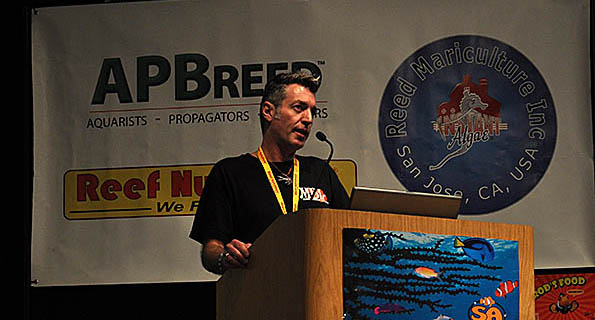
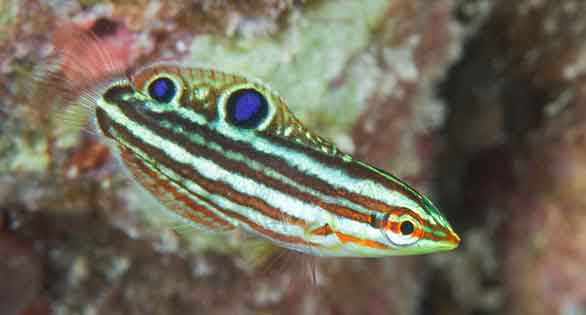





Trackbacks/Pingbacks